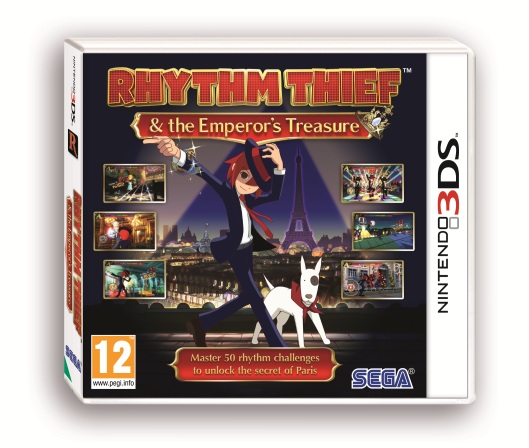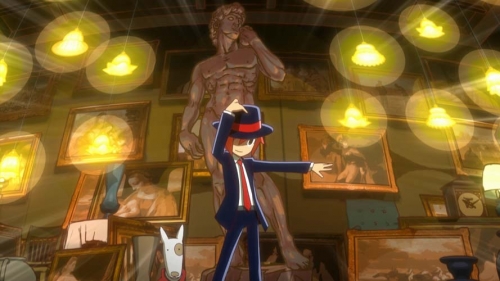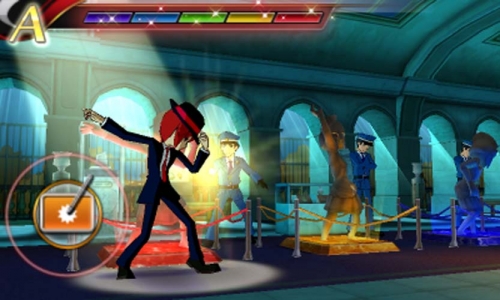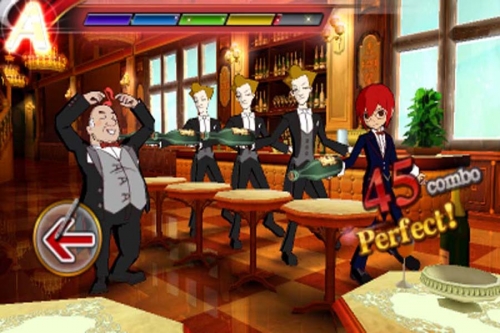Rhythm Thief & The Emperor’s Treasure review
Game Info:
System: Nintendo 3DS
Genre: Rhythm/Adventure
Players: 1-2
Release Date: April 5, 2012 (EU)/July 10, 2012 (US)
Developer: Sega
Publisher: Sega
Whatever happened to rhythm games? Sure, we all saw Guitar Hero and Rock Band achieve mainstream success, but what happened to the weird subset that blended the usual rhythm-based gameplay with unique visual styles and character-driven storylines? While games like Gitaroo Man and Parappa the Rapper became critical hits, the genre seems to have fallen off the radar lately (probably because you didn’t buy Elite Beat Agents*). Thankfully, there’s now Rhythm Thief, a Sega produced “rhythm game revival” of sorts. With the combination of Samba de Amigo director, Shun Nakamura, and Space Channel 5: Part 2 composer, Tomoya Ohtani behind the game it should be a success, but does it successfully follow the path paved by its predecessors?
Turns out it actually doesn’t; Rhythm Thief plays more like a mishmash of self-contained rhythm games, exploration, puzzle solving and plenty of fetch quests. The titular rhythm thief is Raphael, a teenager who assumes the identity of the musically inclined Phantom R. On the run from the Paris police, who really should’ve seen through his awful disguise by now (it’s just a hat), Raphael and his canine companion Fondue have to solve several mysteries around the city and stop the plans of the evil Emperor Napoleon, who has apparently been resurrected as a one-dimensional villain. I’d hesitate to call the plot “good”, but if the developer’s goal was to evoke memories of earlier rhythm games with their cheesy dialogue and often-nonsensical storylines, then I suppose they did a decent job. Rhythm Thief never gets quite as crazy as, say, cheerleaders fending off an alien invasion by dancing to a cover of Jumping Jack Flash, but it’s fun and doesn’t take itself too seriously.
For such a stylish dresser, Phantom R sure has some seriously corny lines.
Like in Professor Layton, the action in Rhythm Thief is broken up by several animated sequences. Though the animation quality isn’t amazing, the 3D effect makes everything stand out and the style translates well to the cel-shaded graphics used in the rest of the game. It might have the appearance of an adventure game, but keeping the beat is still central to Rhythm Thief. Even solving puzzles has some sort of musical element, whether it involves pressing buttons in time with music or recording and replaying different sounds.
Solving puzzles is fine and all, but Rhythm Thief’s main draw is definitely the actual rhythm games. Occasionally Raphael (or other characters) will be thrust into one of several sequences that look like they were lifted straight out of Nintendo’s Rhythm Heaven series. That’s not a bad thing, though; I found Rhythm Thief’s stages were most enjoyable when they were being completely shameless with their inspirations —there are a few hidden ones based on other Sega rhythm games that are well worth hunting down. And while the game is quite strongly influenced by Rhythm Heaven, there are some notable differences between the two games. Success in Rhythm Heaven relies on listening carefully to audio cues and getting a good feel for a song’s beat, to the extent that every level in the game can be beaten without even looking at the screen. Trying to do the same in Rhythm Thief will almost certainly end in the word “FAIL.” plastered on the 3DS’s top screen. Though it helps to have a keen sense of rhythm, the game requires that players pay attention to what’s happening on-screen. That’s not necessarily a bad thing, though; in most cases the visuals complement the music and make it much easier to understand whatever musical concept the game relies on. For example, anyone who played the Nintendo DS version of Rhythm Heaven probably remembers the infamous “Lockstep” level, in particular the several attempts it took to figure out the timing for switching to offbeats. Rhythm Thief has a similar stage, but this time around the different beats are represented by different coloured platforms, so getting the timing right is simple.
There’s a lot of variety to the different rhythm games
Rhythm Thief employs a range of different control schemes, some of which don’t work well at all. Anything using buttons is fine, but sliding the stylus in different directions to hit notes (or worse, drawing circles) feels too imprecise, even though the timing isn’t particularly strict. That said, it’s not as bad as Rhythm Thief’s use of the 3DS’s gyroscope. Even if it’s only for a few levels, relying on horribly imprecise motion controls in a game that’s all about timing is an absolutely terrible idea. One particularly awful stage plays like a rhythm-based Punch-Out. It sounds like a neat idea, but tilting the 3DS to dodge makes it borderline unplayable.
Though the quality of the rhythm games is rather inconsistent, the actual music is always fantastic. The soundtrack covers a range of different genres, but Ohtani tends to use a lot of jazzy pieces with brass instruments featured prominently. It’s all very reminiscent of his work on Space Channel 5: Part 2, but it sounds distinctive. Whatever the style, it’s always very energetic; even when the game becomes frustrating, the music helps to make the whole experience enjoyable —unless the piece happens to feature lyrics. Any time someone sings, the soundtrack turns into the cheesiest, most cringe-inducing music outside of Radio Disney. But then again, I suppose that works just fine as a throwback. The voice acting for the lead characters feels a bit flat, but I appreciate the fact that Rhythm Thief contains some of the most ridiculous French accents since Cosmic Fantasy 2. It’s worth noting that all the dialogue is also voiced in French, which fits well with the setting, but you’ll have to change the 3DS’s language to hear it.
Even the verbal cues are catchy. “Pour….WINE!”
After clearing a rhythm game in the main story, you can replay it for higher grades, scores, or a pretty crown icon from completing a perfect run. It’s just a cosmetic reward, but it provides a nice challenge. On top of this there are various “endless” games and extra episodes that unlock as you play the game. Rhythm Thief has a decent amount of content, even if the story isn’t particularly long. There’s also multiplayer and some sort of Streetpass functionality, but I haven’t run into a single person who owns the game so who knows how it works.
Rhythm Thief definitely has flaws, but it also has a certain charm that manages to pull everything together. The stylish presentation helps to make it stand out, even amongst the games it “borrows” from. Even with the odd mix of gameplay styles, Rhythm Thief doesn’t innovate so much as it serves as a nice throwback to a genre that hasn’t really been revisited in some time –and if this game’s performance in Europe and Sega’s current direction are any indication, might not see again for a while.
Final Score: 7/10
*Unless you did. It’s quite good, isn’t it?



